Comfort in the interior - homemade laundry baskets

Recently, a laundry basket is not only a practical item, but also a full-fledged element of the interior. It fits perfectly into the bathroom environment. There are both metal and wicker products. Since more and more the laundry basket acts as a component of the decor, various homemade counterparts have appeared, in which the craftsmen have applied all their imagination and creativity. The dirty laundry box with a lid can be woven, sewn, made of cardboard or crocheted - it all depends on your skill.


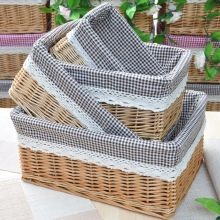
Types of baskets
Laundry baskets are classified by type, based on their shape. If you are seriously thinking about making your own laundry basket, it is advisable to think over its shape in advance, especially if you are the owner of a small bathroom. So, the most common model is the standard linen container. It differs in the materials used in the manufacturing process and in the installation method. Corner and straight containers are often placed near the washing machine. The corner model is necessary in small bathrooms, since it is the corners that are most often not used.


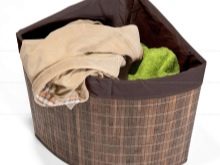
The most practical homemade product is the wall-mounted laundry basket. It is mounted on a free wall or placed in a hanging cabinet. Such a product is not conspicuous when entering the bathroom and does not clutter up the space. Another practical option is the foldable basket, which looks like a standard container. Such a cover is useful for arranging a small bathroom.



Materials (edit)
To make a do-it-yourself laundry basket, the weaving method is often used, so you will need materials suitable for this method to work. In specialized stores, rattan baskets are most often found. This is a peeled and dried rattan stem. The stems have a flexible structure that allows a person to give the product almost any shape.
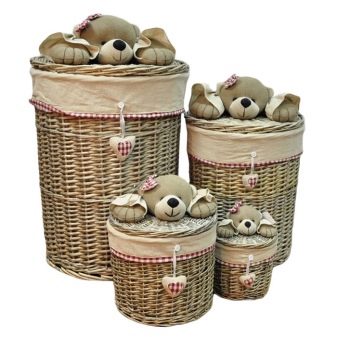
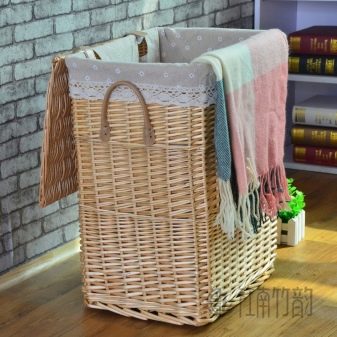
Another popular and demanded material for weaving a linen basket is a vine. It is a type of thin and long stem (most often the stem: herbaceous or lignified). For products, use a vine of a grape tree and willow. Bamboo is also often found from natural materials for weaving a basket. Original products are obtained if you use an ordinary newspaper or textiles in the manufacture. In addition, such baskets are not only unique, but no worse than those presented in stores. It is worth noting that the materials involved in the work process require a minimum amount.

Required tools
There are many variations on the theme of creating laundry baskets at home. After you decide on the model, it is advisable to prepare all the tools required for work in advance. Their choice will directly depend on the type of material with which to work. But the first thing to think about before you start making the basket is its dimensions. It is essential that the product blends harmoniously with the bathroom interior, without looking bulky or impractically small.

For a wooden basket, you will need to resort to a jigsaw and a screwdriver. A sewing machine, scissors, threads and a needle are required for the textile. When using paper materials such as newspapers, finishing of the received product will be required. This is necessary to give strength and moisture resistance to the laundry basket. That requires the purchase of varnish or stain. In addition, for gluing the paper structure, you will need an appropriate composition, for example, regular PVA. Working with plastics requires a different adhesive that is suitable for plastics.



Manufacturing in stages
From newspaper tubes
It is worth replacing, in order to build a container for linen from newspaper sheets it will take a lot of patience, but the process is extremely fun. You will need to cook - a large amount of newspaper. Also stock up on PVA glue, varnish or stain, scissors, a pencil and a thin knitting needle.

First of all, you need to build tubes. To do this, fold newspaper sheets in half and mark seven centimeters on them. Then cut them open. Using a thin knitting needle, twist the resulting strips at an angle of 30 degrees. In the process of twisting, pay attention to one end of the tube - it should turn out to be slightly thicker than the other end. In this case, the tube itself must be tight enough. Then coat the corner with adhesive and leave to dry. Remove the wire from the tube and repeat the procedure to the required number of tubes. In order for the length of the tube to be enough for weaving, it is necessary to glue them together. Put a small amount of glue on the wider edge and insert the thinner tube into it.



It is recommended to start weaving the basket from the bottom of the product.
To execute it, follow the following algorithm:
- First of all, ten tubes must be counted. Lay out the other five tubes along a horizontal line and press down with a ruler.
- Lift each odd tube, and grease the even tubes with a small amount of adhesive.
- Apply the sixth tube to the areas with glue and press it down again. Lower the tubes raised earlier.
- Repeat this procedure again, this time lifting the even tubes. Glue the seventh pipe together.

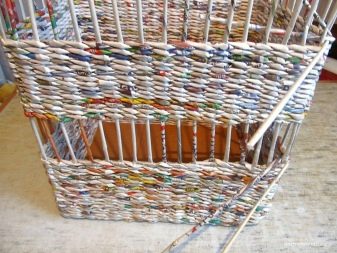
- Continue braiding until all ten tubes are glued together.
- Then rotate the topmost tube, which is horizontal, ninety degrees. Interlace it with the rest of the tubes in the same way.
- Continuing to weave in a circle, try to move the tubes slightly to the sides. This is necessary in order to get a round bottom.
- After the resulting bottom reaches the required size, you will need to bend all the tubes up. For a more comfortable weaving, place any shape on the bottom, which will be the basis for helping you make an even product.

After the bottom is finished, you can start making the side of the basket. After placing the mold, press the tubes against it until snug. Then start braiding the side pieces by threading the horizontal tube over and under the other tubes one at a time. If the horizontal tube is not long enough, drip some glue into its end and push the other tube with a thinner edge. Having obtained the required height, finish weaving. Treat the entire basket with an adhesive, and then apply a layer of stain or paint with any color you like. The final stage will be varnishing the product.

From fabric
To make a practical foldable laundry basket, you will need to stock up on a foldable frame, thread, cotton cloth and a sewing machine. So, first of all, decide on the required size of the future product, taking into account the dimensions of the folding frame. According to the results obtained, cut four pieces from the fabric for the side and one piece for the base of the bottom. Sweep off all parts or secure with safety pins. Using a sewing machine, sew on the wrong side.Unscrew the resulting bag and iron it with an iron if desired. Use the remaining pieces of fabric to create the loops - cut four pieces and, turning the bag on the wrong side, fasten the loops to the sewing machine.


On a plastic frame
Any available plastic material can be taken as the basis for weaving the basket. For example, a soda bottle. In addition, you will need to acquire the following materials: scissors, a ruler, a pen or pencil, a box and a specialized adhesive.
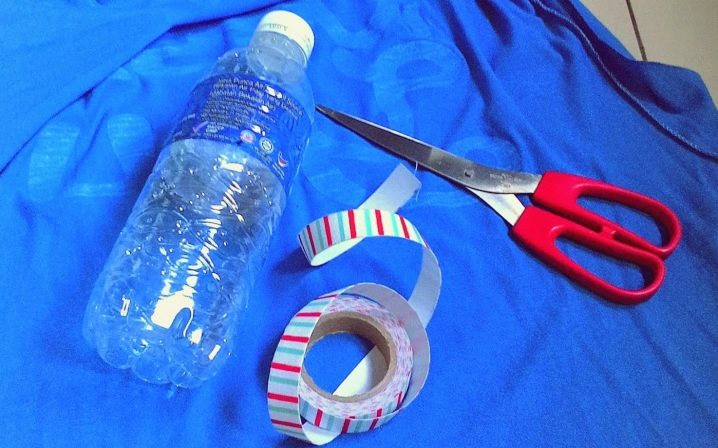
- Use electrical tape to wrap the bottle at a slight angle. Next, using scissors or a utility knife, cut the bottle. You should get a spiral.
- Repeat the procedure with the rest of the bottles.
- Taking the previously prepared box, place it with the base up.
- Place a small amount of plastic strips in the middle. Skip the rest of the stripes between them - simulating a checkerboard pattern.
- After you get the base of the desired size - lift the strips up and fix with an elastic band or rope.
- Braid raw edges into the previous finished row.

From the vine
To make a linen container, you need to acquire the following materials: rods with a diameter of five millimeters and one centimeter, rattan, awl, pruning shears and a sharp knife.
Consider the weaving of the basket in stages:
- Before working with the vine, soak it in cold water for 2-3 hours. Then wrap it in a damp cloth and place in a plastic bag. Rattan is subjected to the same procedure. Then, on several rods, make an incision of five to seven centimeters at the end of the rods, on others, make a small hole in the middle.
- Having inserted an awl through the rods with a hole, a vine with a notch is also threaded. A cross should form.
- One side of the resulting cross is wrapped in rattan.
- Using the left side of the rattan, draw the cross in a circle.



- Repeat the procedure using the right side of the rattan.
- At the end of the second round, rattan is inserted between the twigs of the vine.
- Next, six rows are woven. Then the vine is cut into sixteen pieces and sharpened at the edges.
- After you get the required size of the base of the basket, you need to divide the rattan and the vine into rods, the length of which is seventy centimeters and insert them into the bottom of the basket.
- It is definitely recommended to do one more row to fix the base and bend the rods up. This will be the base for the sides of the basket.
- Use a rattan to wrap the upwardly bent rods until you reach the required height. To get neat edges, you will need to weave the curved rods into the previous finished row.



Best options
The original laundry basket is obtained from a newspaper. Such a product is not only unique, but no worse than the models presented in stores.
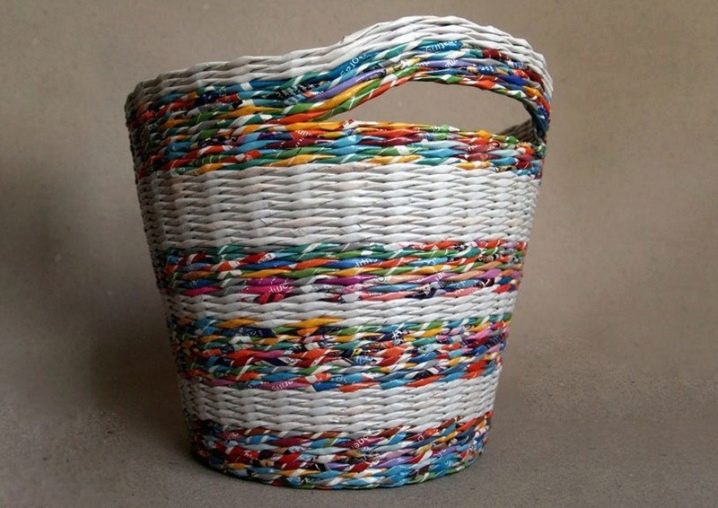
The most popular material for weaving a linen basket is a vine. For the manufacture of such products, grape and willow raw materials are used. To further decorate the wicker model, you can add satin ribbons to its design.
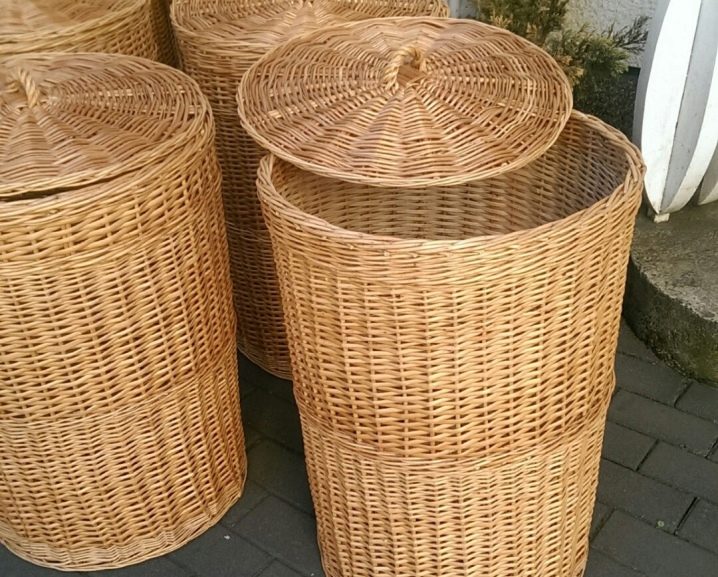
The most practical option is the convertible basket. You can make it yourself using a folding frame and a piece of fabric. If desired, the product can simply be folded and put away in another place.

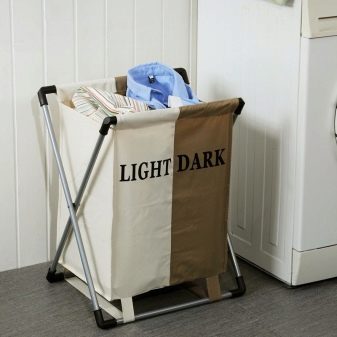
What to make a laundry basket from, see this video.











The comment was sent successfully.